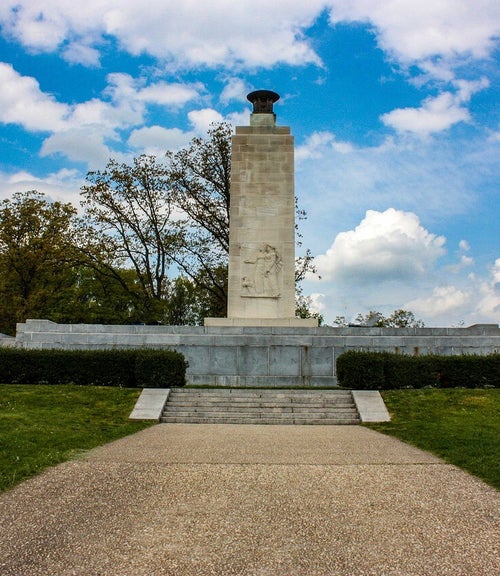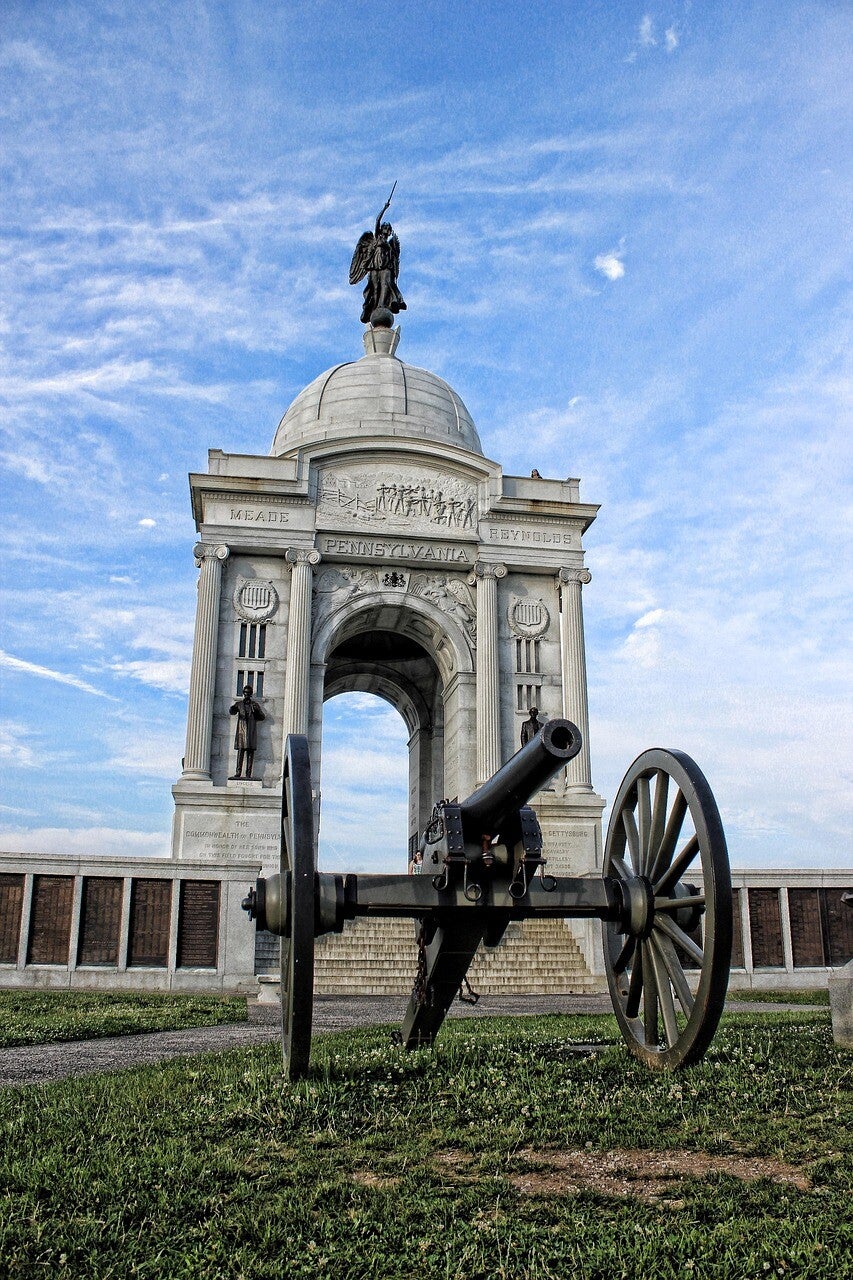Gettysburg National Military Park
Flames once Fueled by Rage, Now Burn for Unity

The Light That Never Goes Out: What Gettysburg’s Eternal Flame Teaches Us About Forgiveness
Gettysburg: A Landscape of Memory and Meaning
In the rolling hills of Pennsylvania, where cannon fire once echoed and lives were torn by division, stands one of America’s most solemn landmarks Gettysburg National Military Park. It commemorates the Battle of Gettysburg, fought over three brutal days—July 1 to July 3, 1863—during the American Civil War.
It was the bloodiest battle in U.S. history, with an estimated 51,000 casualties across both Union and Confederate forces. The battle marked a turning point in the war: Confederate General Robert E. Lee’s attempt to invade the North was repelled, and the Union began to regain momentum.
The significance of Gettysburg isn’t just tactical—it’s symbolic. It was here, months later, that President Abraham Lincoln delivered the Gettysburg Address, redefining the war’s purpose as a fight for unity, liberty, and renewal.
And it was here, 75 years after the battle, that former enemies—Union and Confederate veterans—stood together to light a flame that would never go out.
The Eternal Light Peace Memorial: A Symbol of Reconciliation
Dedicated in 1938, the Eternal Light Peace Memorial was unveiled by President Franklin D. Roosevelt during the 75th anniversary of the battle. The flame was lit by two elderly veterans—one Union, one Confederate—standing side by side.
Its inscription reads:
"Peace Eternal in a Nation United.”
This wasn’t just a tribute to the fallen. It was a declaration: that even after unimaginable division, reconciliation is possible.
It still burns today—not as decoration, but as a quiet promise: that even division can become unity, and wounds can become wisdom.
The memorial doesn’t glorify war. It honors peace. It reminds us that healing is not forgetting—it’s choosing to move forward.
From National Healing to Personal Reckoning
The Civil War tore families apart. It pitted neighbor against neighbor. And yet, decades later, those same men gathered at Gettysburg—not to relive the pain, but to forgive, to reconcile, and to stand together under one flag.
If a nation can do that—after bloodshed, betrayal, and loss—why can’t we?
We may not fight with muskets, but we carry wounds. Grievances. Old stories. And often, we hold onto them like proof of our pain. But the truth is: unforgiveness doesn’t protect us—it imprisons us.
The Hidden Cost of Holding On
Resentment is not passive. It’s active stress. When we hold onto anger, bitterness, or betrayal, our bodies respond as if the threat is still present. Studies show that chronic resentment is linked to:
- Higher blood pressure and heart disease
- Increased anxiety, depression, and cognitive decline
- Sleep disruption and immune system suppression
- Greater emotional reactivity and impaired decision-making
It’s like drinking poison and hoping someone else suffers. But the damage is internal. Quiet. Cumulative.
Emotionally, unforgiveness keeps us tethered to the moment we were hurt. It traps us in a loop of reliving, rethinking, and re-feeling. And over time, it can harden into identity: - “I am the one who was wronged.”
But you are more than what happened to you.
And forgiveness is how you reclaim that truth.
Journaling: A Mirror for What Still Hurts
One of the simplest ways to begin healing is through journal entries —daily reflection through short, honest notes. It’s not about eloquence. It’s about noticing.
When you write regularly, you will begin to see:
- How often anger or pain shows up in your thoughts
- Which situations trigger old wounds
- What beliefs you’ve built around being hurt
- Where you’re still waiting for closure that may never come
Journaling doesn’t erase the past. It helps you understand it. And that understanding is the first step toward release.
Take a quiet moment. Write this down:
- “I’m ready to forgive ______ because I deserve ______.”
Let the words come slowly. Let them surprise you.
This is not a performance. It’s a beginning.
What Reconciliation Can Look Like
Whether with others or within yourself, reconciliation is a process. Here’s how it might unfold:
- Naming the wound: “I was hurt. I was wronged.”
- Acknowledging the impact: “This shaped how I see myself or others.”
- Choosing release: “I no longer want this pain to lead my decisions.”
- Rewriting the story: “I am more than what happened to me.”
Sometimes the person you need to forgive is yourself—for the choices you made when you didn’t know better. For the silence. For the survival. And that’s okay. You’re allowed to evolve.
The Transformational Power of Forgiveness
Forgiveness is not weakness. It’s strength. It’s not surrender. It’s sovereignty.
When you forgive, you:
- Reduce emotional and physical stress
- Gain clarity and emotional regulation
- Improve relationships and communication
- Create space for growth, joy, and new beliefs
- Strengthen resilience and mental health
Forgiveness is not erasure—it’s transformation. It’s the moment you stop being defined by the wound and start being defined by your healing.
A Call to Light Your Own Flame
Next time you pass a memorial—or even a library, a quiet park, a place of reflection—ask yourself:
- What am I still carrying that no longer serves me?
- Who am I allowing to still cause me pain internally?
- What would peace look like in my own life?
- What flame am I ready to light?
You don’t need a ceremony. Just a moment.
Write the letter. Speak the truth. Let go of the weight.
Because if a nation once torn by war can reconcile and rise, so can you.
Forgive. Reconcile. Move forward.
Let your Light Burn—Not in Bitterness, but in Becoming...
Journal Entry: Forgiveness — Gettysburg National Military Park
- What emotional battles have I survived — and what do I still carry from them?
- Who do I need to forgive, not to forget, but to stop reliving the hurt?
- What part of me resists forgiveness — and what is it trying to protect?
- How can I honor the truth of what happened while choosing not to stay in it?
- If my journal were a battlefield map, what areas would show peace — and what still need tending?
Affirmations: Forgiveness — Gettysburg National Military Park
- “I remember what shaped me — and choose not to be defined by it.”
- “Forgiveness is not forgetting — it’s remembering with grace.”
- “I lay down my emotional weapons and walk forward with clarity.”
- “I honor the past by healing in the present.”
- “I am allowed to forgive without erasing — to release without denying.”

Gettysburg
When We Forgive,
Healing Begins..